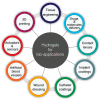Antimicrobial Natural Hydrogels in Biomedicine: Properties, Applications, and Challenges-A Concise Review
- PMID: 36768513
- PMCID: PMC9917233
- DOI: 10.3390/ijms24032191
Antimicrobial Natural Hydrogels in Biomedicine: Properties, Applications, and Challenges-A Concise Review
Abstract
Natural hydrogels are widely used as biomedical materials in many areas, including drug delivery, tissue scaffolds, and particularly wound dressings, where they can act as an antimicrobial factor lowering the risk of microbial infections, which are serious health problems, especially with respect to wound healing. In this review article, a number of promising strategies in the development of hydrogels with biocidal properties, particularly those originating from natural polymers, are briefly summarized and concisely discussed. Common strategies to design and fabricate hydrogels with intrinsic or stimuli-triggered antibacterial activity are exemplified, and the mechanisms lying behind these properties are also discussed. Finally, practical antibacterial applications are also considered while discussing the current challenges and perspectives.
Keywords: antibacterial properties; biomedical applications; hydrogels; tissue regeneration; wound healing.
Conflict of interest statement
The authors declare no conflict of interest.
Figures






References
Publication types
MeSH terms
Substances
Grants and funding
LinkOut - more resources
Full Text Sources

